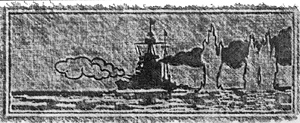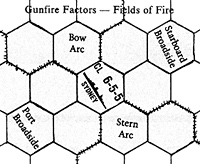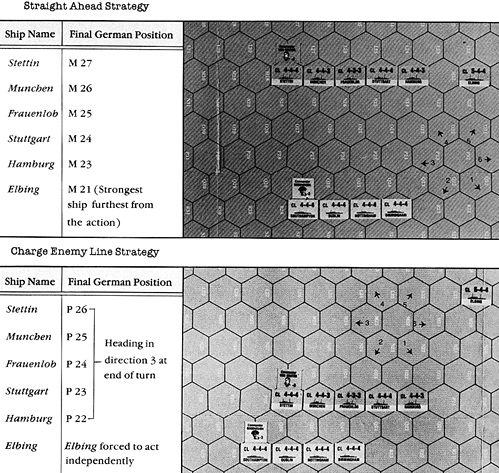 Situation
Situation
One of my favorite scenarios in The Royal Navy is Night Encounter at Jutland. Range is short. Action lasts for only four turns, and the sides are very evenly matched with two of the world's greatest Light Cruiser Admirals in action against each other. I must admit that I love scenarios that can be played in as few as 45 minutes, so that one can replay it several times and try different tactics.
So let us journey back through time to the night of May 31, 1916 in the North Sea. You are Commodore William Goodenough leading four large Light Cruisers of the British Navy. Dim shapes are seen off the starboard side, a bit to the rear at about 3,000 yards. Recognition lights are flashed ... the wrong ones! Gunfire erupts in the night as six smaller enemy cruisers open fire on you. You also note that the enemy rear seems to be in confusion as their ships are in a bit of a jumble. You know that your ships have superior gunfire ship for ship and can penetrate enemy armor better than they can penetrate your armor. What do you do?
May 31, 1916
Confused night actions were to last through the night and into the following day after the daylight fleet action. fought between the Royal Navy and the Imperial Navy. One of the earliest night actions was to be fought by the 2nd Light Cruiser Squadron under the brilliant Commodore William Goodenough and the equally capable Commodore Ludwig von Reuter commanding Scouting Group IV. Looming out of the night at 3,000 yards came vessels that both sides hesitated firing at until recognition lights were flashed.
British: Commodore William Goodenough (-3) on board the Southampton R-23, Dublin R-22, Nottingham R-21, and Birmingham R-20. All are in direction 3 at 3 movement factors (MFs).
Torpedoes-The Brits have 21" torpedoes that when set for slow speed have a range of 17 hexes and a speed of 5-4-4 and 10 hexes at 6-5 when going fast. It is not 6-4 as 6-5 is if you're using simultaneous movement.
 Gunfire factors: The Southampton and Dublin have 7 gunfire factors capable of
firing on either broadside. The Birmingham and Nottingham have 8 each. All these ships
can throw 2 factors directly forward or directly aft except that the Birmingham and
Nottingham could throw 3 factors forward and 2 aft.
Gunfire factors: The Southampton and Dublin have 7 gunfire factors capable of
firing on either broadside. The Birmingham and Nottingham have 8 each. All these ships
can throw 2 factors directly forward or directly aft except that the Birmingham and
Nottingham could throw 3 factors forward and 2 aft.
German: Commodore Ludwig von Reuter (-3) on board the Stettin M-23, Munchen M-22, Frauenloh M-21, Stuttgart M-20, Elbing L-20, and Hamburg M-19. All ships in direction 3, except the Hamburg in direction 4 with all ships at 2 movement factors.
Torpedoes: German torpedoes have a range of 7 hexes except for the 20" ones on the Elbing which have a range of 10 hexes. The smaller older German ships have a 17.7". The one German torpedo speed is 5-4.
Gunfire factors: All the Germans have 7 gunfire factors able to fire on either broadside, but note, with the exception of the Elbing armed with 5.9" guns, the smaller older German cruisers with 4.1" guns don't have the punch that the Brits do with their 6' guns. The Elbing has an additional 3" worth 1 gunfire factor capable of firing to either broadside. All these ships can throw 2 factors directly forward or directly aft.
Visibility is 5 hexes in this night action lasting 4 turns. Special conditions are that neither side may fire torpedoes on turn 1 due to surprise.
Line of sight: Any ship within 2 hexes range of the firing ship or the target ship AND lying between the firing and target ship, may be hit. if you score a hit on the GUNNERY HIT TABLE then you roll one die. On a 5 or 6 the blocking ship is hit instead! 1-4 means the target in question is hit. If more than one ship is blocking, randomly roll to determine which one is hit. Note that, a ship in the same hex can be blocking too (as well as resulting in a roll on the potential collision table).
Victory Conditions: Victory is strictly based on victory points. The winning side must have 3 more victory points than the loser. All other results are a draw.
Aftermath: Searchlights were switched on by the Southampton and Dublin which resulted in 18 real quick hits, though the 4.1 inch gun was incapable of deep penetrations at this range. However, the German line also used searchlights which also resulted in numerous hits against them. The Frauenloh took a torpedo hit from the Southampton and quickly sank.

The Royal Navy Strategy Solution
The optimum first turn tactics for the British player is as follows. Steam directly ahead and at full speed. This gives you two advantages, namely a slight lead on the enemy line so you can concentrate gunfire on his lead ships and superior position for launching torpedoes.
By concentrating with gunfire on the head of the enemy line, you may slow a lead ship, thus either slowing the entire enemy line or else creating confusion as faster ships in the rear attempt to pass slower ones. You also have a better chance, especially if the Southampton and Dublin concentrate fire on the enemy flagship, of possibly killing Commodore von Reuter, the enemy commanding officer. That occurred in one game I played and the leadership advantage gained by the Brits in that instance is tremendous. The advantage for torpedoes is obvious. Torpedoes fired at ships steaming towards you while in chase are more likely to hit than torpedoes fired at a fleeing target. Thus chasing a target.
Another advantage gained is that the enemy will either close the range, and by doing so not keep pace with your advance, or else by steaming directly ahead, not closing the range. This gives the British the advantage of penetration. The British 6 inch gun will penetrate enemy belt and deck armor while the German 4.1 inch gun will not. The German player cannot nave it both ways!
The only disadvantage to this tactic is that your rear will receive an undue amount of punishment while you pummel the enemy van. I have not devised a way of avoiding the rear attack unless you know the enemy will try to close the range immediately by turning to the port and charging your line. You could turn away from the enemy to keep the range the same. But if the enemy does not close in, the action is immediately over since you can not see the enemy, and the action results in a draw.
Charging the German line will simply cause a melee with chance being the final arbitrator. It gives the smaller but more numerous Germans an advantage.
Jack Greene is the President of Quarterdeck Games Inc. and the designer of Royal Navy.
Night Encounter at Jutland, scenario #6 for The Royal Navy, is reprinted with permission of Quarterdeck Games Inc.
Straight Ahead Strategy
Ship Name and Final German Position
- Stettin M 27
Munchen M 26
Frauenloh M25
Stuttgart M 24
Hamburg M23
Elbing M 21 (Strongest ship furthest from the action)
Charge Enemy Line Strategy
Ship Name and Final German Position
- Stettin P 26
Munchen
Frauenloh P 24
Stuttgart P23
Hamburg P 22
(above Heading in direction 3 at end of turn)
Elbing Elbing forced to act independently

Counter art and map courtesy of Quarterdeck Games
Back to Table of Contents -- Game News #6
To Game News List of Issues
To MagWeb Master Magazine List
© Copyright 1985 by Dana Lombardy.
This article appears in MagWeb (Magazine Web) on the Internet World Wide Web.
Other military history articles and gaming articles are available at http://www.magweb.com